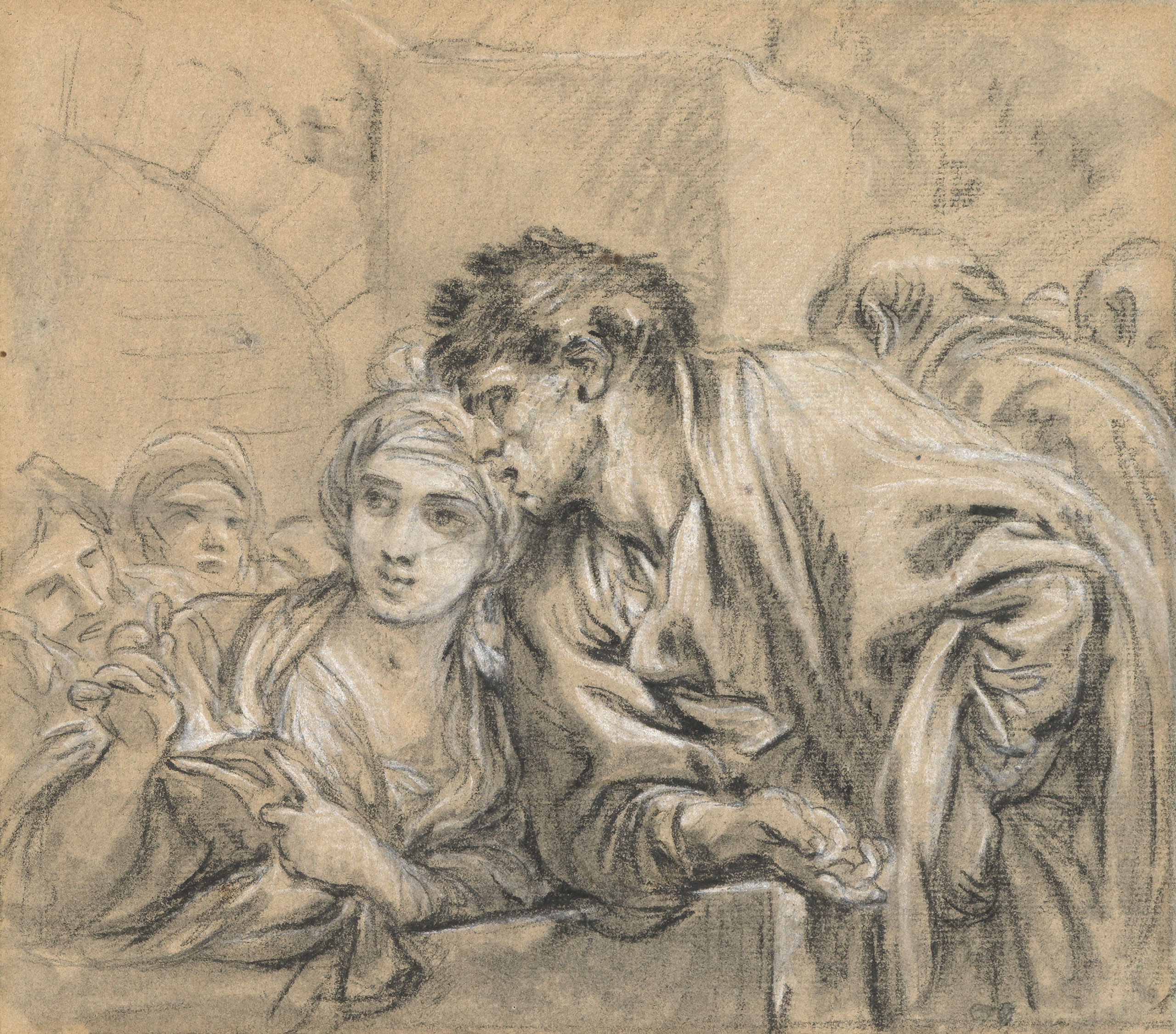
Boucher
François
A Man and a Woman Conversing, Leaning against a Balustrade
Inscribed vente Falconet and numbered 54 on the mount.
Black chalk and white chalk on brown paper.
240 x 275 mm (9 1/2 x 10 3/4 in.)
Provenance
Étienne-Maurice Falconet (1716-1791), Paris, 10 December 1866, lot 54 : « Composition de plusieurs figures. Au crayon noir rehaussé de blanc » (Composition of several figures. In black chalk heightened with white), sold for 30 francs.
Leaning against a balustrade, a man and a woman in the crowd are engrossed in an enigmatic conversation. Wearing a turban, the female figure points to a small, hook-shaped object in her hand. The man seems to be giving his opinion. Dating from the artist’s maturity, this drawing can be compared to a small group once identified by Alastair Laing, a half-dozen studies of similar spirit and technique,1 never clearly related to painted compositions. Boucher’s use of stumping is perhaps more marked than usual. In one of them, formerly in the Lucien Guiraud collection and then in the Cailleux gallery,2 appears a male figure very similar to our own. These gatherings of figures are reminiscent of the large-scale compositions of markets, washerwomen and caravans, themes already explored by the artist in Italy, and to which he returned in the 1760’s.3 Could our drawing be a fragmentary, unused study?
Alastair Laing has suggested that some of these studies may have been made by Boucher as models for his pupils. For example, Jean-Baptiste Deshays sometimes used his master’s drawings to create tapestry cartoons. He did not repeat them literally, but drew inspiration from them to find his own formulas.4 It is also interesting to note, as Alastair Laing does regarding a Study of Boreas, the reciprocity of influences between the pupil and the master, who on several occasions towards the end of his career adopted “a staccato style very close to that of his late son-in-law”.5 This is notably the case in our drawing, where the faces in the background are treated in that schematic, square manner characteristic of Deshays.
Praised for his virtuosity, François Boucher, “born with brush in hand”,6 was long considered the “Painter of the Graces”. The ease and seductiveness for which he was often criticized during his lifetime do not obscure the painter’s impeccable technical and graphic mastery, as well as his great visual culture, which enabled him to impose his style for most of the century. An assiduous draughtsman, he was also professor of drawing at the Académie Royale de Peinture et de Sculpture from 1737, and seems to have fulfilled his task with care. Of varied techniques and subjects, his numerous drawings are always of the highest quality; often copied, used by his pupils and abundantly engraved, they were one of the main vectors of his influence.
This work has been examined by Alastair Laing, who has confirmed its authenticity.
-
See Alastair Laing, Les Dessins de François Boucher, Paris, Éditions Scala, 2003, p. 147.
-
Cailleux Gallery, Boucher, exhibition catalogue, Paris, 1964, n° 87.
-
The Return from the Market and The Rest by the Source (1769 and 1765; n° 71.2 and 71.3, both donated by Peter Parker’s heirs).
-
See Alastair Laing, op. cit., p. 144, regarding Study of a Desolate Young Woman Leaning against a Plinth.
-
Pierre-Jean Mariette, Abecedario, Paris, J. B. Dumoulin, 1854, p. 166.

